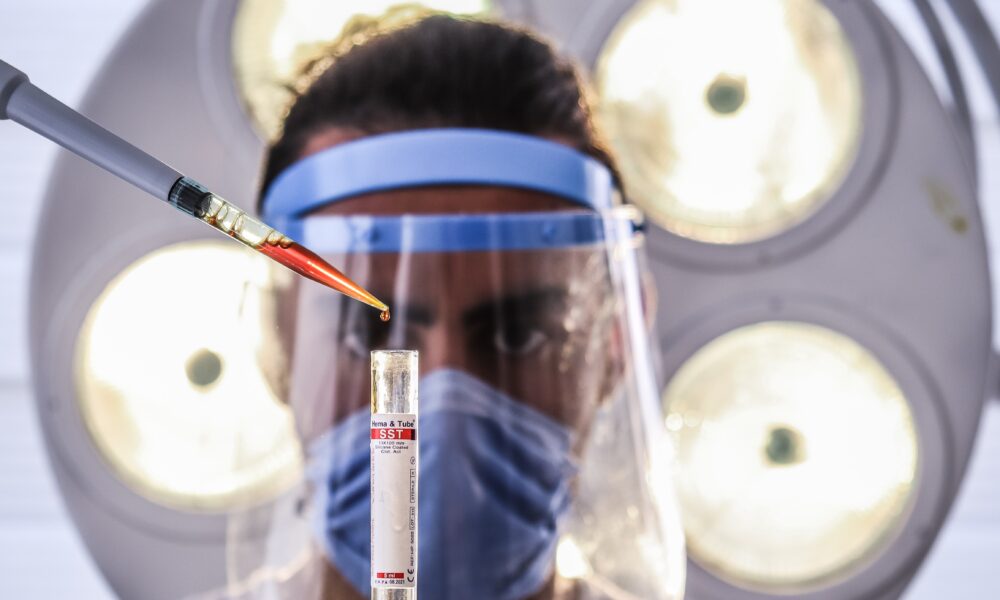Although the Omicron COVID-19 variant emerged in November 2021, scientists are just beginning to trace how the massive surge of infections unfolded by testing blood samples from throughout the pandemic. This is because antibodies against COVID-19 can be detected in blood for months after an infection.
The analysis was led by Bruce Mazer, professor in McGill’s Department of Pediatrics, and David Buckeridge, professor in McGill’s School of Population and Global Health. They explored the evolution of COVID-19 seroprevalence—the number of people with antibodies left over after an infection—between May 2020 and March 2023, using blood samples from a variety of sources, including the Canadian Blood Services and Hema Quebec.
Their main finding was striking. In late 2021, before Omicron was widespread, less than ten per cent of Canadians had been infected with COVID-19.
“[But in December 2021,] it went crazy,” Mazer said in an interview with The Tribune. “There was this steady increase upwards from the winter of 2021 […] until it peaked around late summer 2022, hitting around 70 per cent.”
As of March 2023, the most recent month analyzed, this number was 75 per cent.
Differences between age groups were another major trend in their research. Over 80 per cent of people in the 17-to-25 age group, the youngest one included, had been infected, above the national average. For each subsequent age group, infection rates decreased, with the oldest age group, 65 years and older, lingering around 60 per cent.
“We really have a population age breakdown,” Mazer said.
The study also established that provinces displayed distinct infection patterns.
“We covered the geographical areas of Canada, showing that [cases in] the Atlantic provinces were […] the lowest among all provinces,” Mazer said. “And then they caught up quickly during Omicron.”
Many of these findings will not be a surprise to anyone who kept track of Canadian case counts during the early years of the pandemic. In fact, one of the most surprising conclusions for Mazer was that preliminary case estimates were relatively accurate.
“When we started serosurveillance [the testing itself of blood samples], one of the predictions was that there was going to be a lot of under the radar infections […] [but] in the first two years of the pandemic, there was no hidden tip of the iceberg,” Mazer said.
However, seroprevalence offers additional information that positive polymerase chain reaction (PCR) tests alone cannot provide. Since antibodies remain in the blood for months after infection, they can be used to estimate the total number of infections over time. Relying on test data also became impossible later in the pandemic.
“[Around the time of the Omicron wave], we lost the ability to do PCR […] once provinces decided to stop funding [it].” Mazer said, “Broadly, there was no way to track the numbers at all.”
This study is therefore the first to accurately measure Canadian infections during the later part of the pandemic.
Despite its advantages, studying seroprevalence still has its challenges. Developing a reliable test for antibodies was the biggest obstacle, as it required researchers to find differences between antibodies against COVID-19, and those from colds and other minor respiratory illnesses caused by other coronaviruses. Constant monitoring is also necessary to ensure the tests can detect antibodies against new variants.
However, the technique still provides a powerful understanding of infection patterns. In addition to evidence of prior infections, the antibody testing also showed that elderly people in long-term care lost their antibodies rapidly after vaccination.
“We brought that data to the government,” Mazer said.
“We said, if you’re going to roll out boosters, you [need to] roll them out really quickly in long-term care because they’ve already lost their protection […] And the government listened.”
Despite the many applications for the data, the huge number of people who were infected with COVID-19 remains the most significant fact for Mazer.
“[In the past 100 years,] there’s never been an infection that’s infected 80 per cent of a population in a year,” Mazer said. “This is unprecedented. […] Everybody would say to each other, oh, everybody’s got COVID. Well, we really have the data to prove it.”








